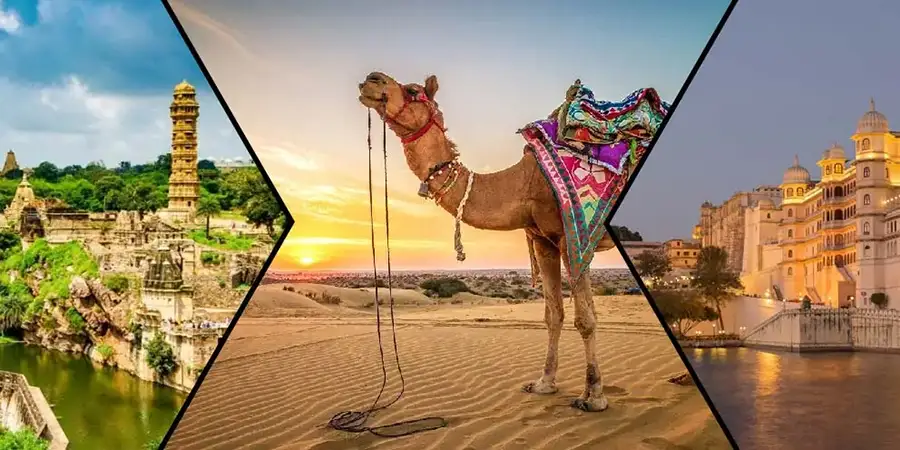Jaipur – The Pink City’s Royal Grandeur
As the capital of Rajasthan, Jaipur is often the first stop for travelers. Known for its iconic pink-colored buildings and rich architectural heritage, it reflects the grandeur of Rajput royalty. The Amber Fort, perched on a hilltop, offers stunning views of Maota Lake and intricate mirror work inside its Sheesh Mahal. The City Palace, still home to Jaipur's royal family, exhibits centuries-old textiles, manuscripts, and armory. The nearby Jantar Mantar, a UNESCO World Heritage Site, is an astronomical marvel that showcases the scientific advancement of ancient India.

Udaipur – The City of Lakes and Living Royalty
Udaipur’s reputation as one of India’s most romantic destinations is well-earned. The majestic City Palace complex overlooks Lake Pichola and is a testament to Mewar dynasty splendor. The palace’s courtyards, balconies, and towers offer panoramic views and house priceless artifacts. Beyond the city, the Udaipur Outskirts Village Walk gives a deeper insight into rural life in Rajasthan, offering encounters with artisans, farmers, and age-old customs that remain untouched by modernity.
Jodhpur – The Blue City of Warriors
Dominated by the mighty Mehrangarh Fort, Jodhpur tells tales of gallant warriors and architectural brilliance. The fort towers over the blue-washed cityscape and offers a well-preserved museum, showcasing royal palanquins, weapons, and costumes. The Umaid Bhawan Palace, part royal residence and part luxury hotel, adds another layer of splendor to the city. Jodhpur's old city streets, lined with spice markets and traditional crafts, offer authentic glimpses into Marwari culture.
Chittorgarh – Echoes of Heroism and Sacrifice
The historic city of Chittorgarh is synonymous with tales of bravery, particularly the legendary act of Jauhar led by Rani Padmini. The Chittorgarh sightseeing tour takes visitors through the sprawling Chittorgarh Fort, one of the largest in India. Highlights include the Vijay Stambh (Tower of Victory), Kirti Stambh (Tower of Fame), and the Meera Temple dedicated to the poet-saint. These structures narrate a poignant history of Rajput resistance and devotion.
Mount Abu – Rajasthan’s Serene Hill Station
While Rajasthan is known for its deserts and forts, Mount Abu offers a different landscape—cool, green, and peaceful. Situated on the Aravalli Range, it is home to the intricate Dilwara Temples, built between the 11th and 13th centuries. These Jain temples are revered for their marble craftsmanship, each pillar and dome carved with unmatched finesse. The Nakki Lake and Guru Shikhar (highest point of the Aravallis) provide tranquil views and a refreshing contrast to the desert plains.
Bikaner – The Desert Jewel of the North
Often overlooked, Bikaner houses the lavish Junagarh Fort, built in the 16th century. Unlike other forts in Rajasthan, this one is not on a hill but features exquisite interiors and courtyards within its complex. Bikaner is also famous for its camel breeding farm and Karni Mata Temple, where rats are revered. These unusual attractions add unique character to the royal narrative of the city.
Bundi – A Hidden Gem with Painted Palaces
Bundi may be less famous than its neighbors, but its charm is undeniable. The Taragarh Fort and Garh Palace are adorned with some of the best-preserved murals in Rajasthan. Wander through narrow lanes to find ancient baoris (stepwells), frescoed havelis, and vibrant bazaars. Bundi’s unspoiled authenticity offers a quiet, artistic counterbalance to Rajasthan’s grand cities.
Kumbhalgarh – Fort of Walls and Wilderness
Known for having the second-longest continuous wall in the world after the Great Wall of China, Kumbhalgarh Fort is a UNESCO World Heritage Site nestled in the Aravalli hills. Built by Rana Kumbha in the 15th century, it served as a strategic refuge for the Mewar rulers. Surrounded by the Kumbhalgarh Wildlife Sanctuary, this destination combines architectural legacy with a dose of nature.
Explore the Diversity of South Rajasthan
For those seeking a culturally rich and visually diverse itinerary, the South Rajasthan Tour covers a blend of lesser-explored destinations such as Dungarpur, Banswara, and Ranakpur. These places are known for their tribal culture, intricate temples, and verdant hills, offering a refreshing departure from the traditional desert imagery associated with the state.
Travel with Experts Who Understand Royal Rajasthan
Choosing the right travel partner makes a significant difference when navigating a land as rich and complex as Rajasthan. A trusted Tour Operator in Rajasthan ensures not just seamless logistics but also curated experiences that honor local traditions, support community artisans, and maintain sustainable travel practices. With deep regional knowledge, the right operator connects you with the soul of Rajasthan, going beyond surface-level sightseeing.
Conclusion
Rajasthan’s royal locations aren’t just destinations—they are living museums of history, culture, and resilience. From the grandeur of Jaipur and Udaipur to the warrior tales of Chittorgarh and the peaceful hills of Mount Abu, each stop is a chapter in India’s majestic past. Whether it’s your first visit or a return journey, exploring these regal cities on a well-crafted itinerary promises lasting memories and meaningful connections. Make your journey extraordinary by choosing immersive, responsible travel through experts who live and breathe Rajasthan.